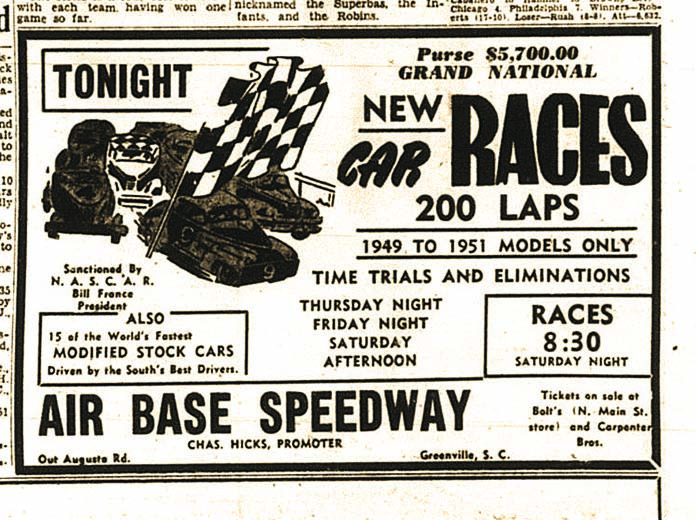Given the delayed start and slow pace of the race, official results were not available at press time for Sunday’s Greenville News. A search through later editions of the paper failed to turn up anything further about the race. Both the News and NSSN named Bob Flock the winner, Tim Flock second and Fonty Flock third. However, Greg Fielden’s “Forty Years of Stock Car Racing” places Buck Baker in third. Fielden listed finishers down to 15th place (out of a known 36 starters), but “drivers listed in positions 6-15 are not necessarily in correct order.”
Bob Flock’s win at Air Base would be his only GN victory in 1951. Entering only 16 out of 41 races, Bob Flock ended the season 16th in points. Because NASCAR scheduled two GN races on the same date at distant locations on several occasions, no driver could possibly compete in every race. The 1951 champion, Herb Thomas, made 34 starts, more than any other driver. Fonty Flock started 33 races and placed second in points, while Tim Flock led all drivers with eight wins and placed third in points.
Making only 10 starts, Taylor finished seventh in points. He won no races, but finished second in the Southern 500 at Darlington (S.C.) Raceway, a week after the race at Air Base Speedway. Baker entered only 11 GN races in 1951, but began running nearly the entire circuit in 1953. He scored back-to-back championships in 1956 and ’57. One week following the Aug. 25, 1951, NASCAR GN event at Air Base, Baker and two other promoters leased the track and presented NASCAR modified races.
Air Base Speedway – Greenville, S.C. – Aug. 25, 1951
Known Starters: E. W. “Buck” Baker, Billy Carden, Jim Delaney, Erick Erickson, Joe Eubanks, Bob Flock, Fonty Flock, Tim Flock, Frank Mundy, Dell Pearson, Lee Petty, Dick Rathmann, Ed Samples, L.G. “Buddy” Shuman, Bill Snowden, Gober Sosebee, Jesse James Taylor, Donald Thomas, Herb Thomas, Curtis Turner
Other Entrants: Weldon Adams, Jimmy Ayers, Robert “Sonny” Black, Robert “Red” Byron Jr., James “Buck” Clardy, Doug Cox, Walt Crawford, Johnny Deaver, Wade Fields, Frank Grubb, Speedy Hudson, Jimmie Lewallen, Johnny Mantz, Everett “Cotton” Owens, E.C. Ramsey, E. G. “Fireball” Roberts, Charlie Rush, Jack Smith, Louise Smith, J.W. “Rex” Stansell Jr., Marshall Teague, Jimmy Thompson, Roscoe Thompson, “Speedy” Thompson, John C. “Pappy” White.
The above text lists the 21 drivers known to have qualified for the Air Base Speedway 200-lapper. Another 25 drivers were named in the News as having filed entries for the race. Among the known entrants are five who have no other record of GN competition — Johnny Deaver, Frank Grubb, “Speedy” Hudson, Charlie Rush and Jessie William “Rex” Stansell Jr.
Deaver was an accomplished short-track driver, who won three track championships at South Carolina tracks in 1954. Rush also raced modified and sportsman cars successfully, including a 1950 feature win at Air Base Speedway.
Stansell lost his life in July 1952 following a wreck at Darlington. Nothing further has been learned about Frank Grubb, however, Johnny Grubb, also of Greensboro, N.C., was a strong modified competitor, who entered five GN races in 1950 and ’51.
Contemporary advertisements and news articles confirm Brown’s information that Air Base Speedway was located near Donaldson Air Force Base off U.S. Highway 25.
Founded in 1942, Donaldson Air Force Base was deactivated in 1963 and became Donaldson Center Airport.
We’ve not located any maps or aerial photos that show the speedway. If it was 10 miles south of the city center, as Brown states, it was probably close to present I-185, the Southern Connector Highway. Greenville-Pickens is on the north side of U.S. Highway 123, about six miles west of downtown Greenville. There’s no question Air Base and Greenville-Pickens were separate facilities.
Why the confusion?
Greg Fielden’s “Forty Years of Stock Car Racing” is the ultimate source on early NASCAR racing. It includes the results of 1,579 races. Although Fielden’s sources are unknown, he clearly didn’t have access to a full, official record of the Air Base Speedway event.
It’s likely that Fielden’s sources named “Greenville,” but did not identify the track (as NSSN did in its race result bulletin). Thus, Fielden may have simply assumed the race took place at Greenville-Pickens because this track hosted 28 Cup races between 1955 and ’71.
Special Thanks: We thank the staff of the South Carolina Room in the Hughes Main Library for facilitating our research. We also thank Timothy Fehler, professor of History at the Furman University in Greenville, for performing additional newspaper research on our behalf.
